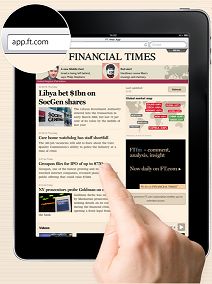The Managing Director of FT.com revealed to me some of the lessons he's learned from thinking retail, and shed light on the next big challenge for FT's paywall after mobile.
The Financial Times made media headlines in June 2011, when the business paper launched an HTML5 app and began selling subscriptions to readers directly via mobile web, opting to avoid the hefty 30% cut Apple requires for doing business inside its virtual gated community.
This was part of a larger shift in the FT's digital strategy, Managing Director of FT.com Rob Grimshaw explained earlier this year, which involved rethinking the operation as more similar to that of a retailer, and considering the reader as more of a customer. In a call, Grimshaw revealed to me some of the lessons he's learned from thinking retail, and shed light on the next big challenge for FT's paywall with the twin revolutions of mobile and social.
Lessons in Retail
"Customers are very demanding" - Rob Grimshaw (@r_g), Managing Director of FT.com
The FT's choice to pull out of the App Store game* closely paralleled its earlier decision to start selling subscriptions to and through its website. As Grimshaw puts it, "It's a process of disinter-mediation really. We used to distribute our product by selling to wholesalers, and we sold it to retailers, who then sold it to the consumer. What we've done online is bypass the wholesalers and retailers, and gone direct to market".
The advantages of creating this direct relationship with readers, ie. cutting out the middle men and getting much more precious user data, also required new skills. "Customers are very demanding" Grimshaw pointed out, and so the FT had to develop a very effective customer service operation, which was something the company "didn't necessarily need" in the pure print days. Add that to the new infrastructure required for billing, payment, customer relationship management, and suddenly the once print-only news operation does indeed start to take on online retailer characteristics.
Unsurprisingly, Grimshaw's inspiration for how to act more like a retailer did not come from his peers in the publishing industry. He looked at the likes of Amazon, Tesco, Zappos, "companies that had built their businesses around dealing with customers online and marketing to them effectively". It was an experience that was "transformational" for Grimshaw, and part of what led to the FT's deep understanding of the value of reader data, and its impressive success in combing it with cheaper marketing channels like email to "tremendous effect". In July this year, digital subscriptions overtook print circulation for the first time.
Twin Revolutions for Paid Content Online
With the current flood of paywalls (the number doubled in the US last year), there is plenty of variation on price points and metered models. What I asked Grimshaw to speculate on was, what will the paywall look like 1 year down the line? What is the next big thing going to be for paid online content at the FT?

Grimshaw explained that his big focus initially had been how to make this content portable, and how to give the user a smooth experience accessing their subscriptions with the same credentials across a wide array of devices? In the twin revolutions of mobile and social, this was the first objective, allowing readers to take the content with them physically. And the FT has had considerable success, with more than 280,000 people around the world reading the FT on more than one channel daily: 14% of its total global audience. Mobile now also accounts for 15% of new subscriptions, and 25% of the traffic to FT.com. Having accomplished physical content portability, Grimshaw's next challenge was to allow readers to take the content with them virtually.
There is a fundamental limitation all online publishers share in Grimshaw's opinion:
"In order for us to make money right now, we need people to come to us"
He suspects that as people become more reluctant to leave their ever more encompassing social environments online, they will want to increasingly pull things into their world. So this is what Grimshaw and FT.com are working on, exporting monetisation to other platforms, be that Facebook, Google+, or any other social platform. Just as the HTML5 app makes the FT experience portable physically, Grimshaw wants to make the brand experience (plus the advertising and subscriptions businesses that go along with it) portable virtually.
* NB: The Financial Times still offers an Android app through Google's Play store, and has recently released Windows 8 application with free unlimited content for a limited time.